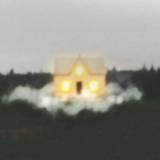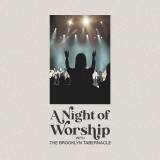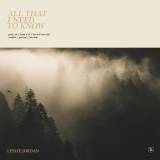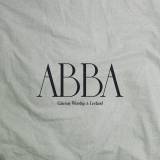Simplicity in Worship

Many times while playing in a worship team I find the impulse to over play. Whether it’s playing a walk on every bass line, playing with way to much delay on electric, or adding enough hammer-ons to each acoustic chord to nail the stage together, the tendency to overplay seems natural. Unfortunately, overplaying can be destructive when playing with a band, especially in a worship context.
Pie Concept
When playing with a band it’s important to remember that the goal is to move forward as a team and not stand out. There is nothing worse in a worship band than someone trying to fulfill his/her rock star fantasies on stage (Guilty as charged). Music with a band can be looked at like a pie. There is a limited amount of it and if you take more than your share then someone has to do with less. Primarily this concept has to do with tonal space. Every instrument has its own space. Kick Drum and Bass on the low end, Acoustic and Piano in the middle, and typically Electric on top. This can get hairy when you have a 4+ member band (Not counting leaving some Pie for the vocals). It’s important firstly to understand your instruments role in the type of band you play in. Obviously on guitar driven songs the guitar will take more of the pie than the piano and vice versa.Less is More
Often times when playing with others (especially in worship) LESS IS MORE!!!! It’s worth repeating: LESS IS MORE!!! Keep it simple. There are times for heavy riffs and solos but often times playing simple and doing your little part is what makes the difference between an ok band, and a great band. The most important concept that I still am trying to learn, is to listen first and then ask what I can add. If there is already someone plunking out the rhythm, then it would make more sense to play a light part over the top. For Example: Listen to the song Desert SongListen for the simple piano arpeggio, simple drum beat, simple electric lead, simple driving bass, and simple acoustic rhythm. There are no flashy solos or hair brained drum fills, yet the song is still immensely powerful. Everyone is simply doing his/her part.
I could go into a ton of detail here about each instruments role (which I probably will at some point) but for now I will head my own words and keep it simple.
Let the Song Breathe
MYTH BUSTERS!!! Just in case there was any doubt in your mind. No. You don’t have to play 100% of the time. It’s a shocking concept (especially for us guitar players). It’s ok for you to sit back and let the song breathe. Personally, the compulsion to play all the time seems to stem from my “on stage syndrome”. It’s easy to feel uncomfortable in front of people without playing and to use your instrument or voice as a safety net for your own nerves. Also on nights when I’m tired or too lazy to actually engage in worship I find it easy to just sit back and play the music. If I was to not play for even a brief moment I might actually have to engage in actual worship. (Scary!!! I know)Listen to the song Carried to the Table by Leeland
The drums and bass don’t play a note till 4:30 in this 6 min song. Silence in worship can feel awkward to you on stage but sometimes it’s ok to wait on the spirit and keep things soft. The words are the most important part of worship anyways.
The Fix
Preparation, preparation, preparation. Most of the things I described earlier are symptoms of not being prepared. When I try to wing it, I am usually so concerned on just hitting the right notes that things like taste, blend and dynamics take a back seat. Take the time to think about what you will play before the preceding measure. When you practice (often), take the time to orchestrate the song. Think about how what you plan to play will mix with the other band members and the vocals. Think about the dynamics of the song, and what you can do to draw people into worship. (Remember: Less is more) Then practice these parts up to speed with a metronome. To many times we consider being able to play the chords of the song in the right order, being prepared. That is nothing more than laziness. God and the members of your church deserve more from you.One last point. Listen to music don’t just hear it. It does not matter how much you practice if you don’t know what to play. When you listen to a song that you are supposed to learn, don’t just play it a couple time and then think you know it. Peter James from Hillsong wrote this blog on how to “Listen with the intent to learn” http://hillsong.com/blogs/creative/2010/02/25/listening-musical-influences/ He talks about not just listening to a song, but dissecting the song. While his blog is particularly aimed at keyboard players, he poses some great questions to answer when “listening with the intent to learn”
Try to incorporate these basic questions into your listening/learning time.
“1/ What tone or tones are they using?
– How does the tone fit within the style of the song?
– How are they producing this sound and how can i replicate it?
2/ How are they layering the sound?
– Are they using more than one sound?
3/ What effects are they using and why?
– How are they manipulating these effects in realtime?
– How can i incorporate some of these effects into my ’sound’?
– Delays, Filters (e.g. low pass filters), Reverb, Overdrive etc
4/ What kind of rhythms and riffs (parts) are they using and why?
– Are these riffs clashing with the other musicians parts and/or melody?
– Are these riffs leaving room for the other musicians and melody? If so how?
5/ What are they doing to build the song dynamically?
– Are they using the about 4 things: Effects, Tone, Layering, Rhythms & Riffs to do this?
– How can I learn from this and incorporate it into my playing.”
As worship musicians we should always be seeking to refine our craft for the purposes of reaching more people. Keep practicing, keep listening and keep humble. If you have any thoughts or questions please comment.
Simplicity in Worship
 Reviewed by Admin
on
12:00:00 PM
Rating:
Reviewed by Admin
on
12:00:00 PM
Rating:
 Reviewed by Admin
on
12:00:00 PM
Rating:
Reviewed by Admin
on
12:00:00 PM
Rating:
















Post a Comment